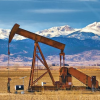In September 2020, geologist Jay Temple began living part-time at an RV park just outside Westcliffe, Colorado, a small high-altitude town. Located between two sets of mountains — the craggy Sangre de Cristos and the Wet Mountains — it is a geologist’s heaven.
In Custer County’s Wet Mountain Valley, Temple investigates old reports of mineral deposits and uses modern techniques to see how they hold up. It’s part of a United States Geological Survey program called Earth MRI — or Earth Mapping Resources Initiative — which aims to identify geological formations across the United States that could contain “critical minerals,” as defined by the Department of the Interior. Such minerals are useful to industry and defense for everything from cell phones to weapons. Because the minerals are often extracted overseas, they are also subject to supply-chain disruptions — from trade disputes, for example, or a pandemic.
Finding these minerals in domestic deposits could reduce U.S. dependence on foreign supplies. But these deposits aren’t always simple to find, in part because they aren’t limited to public lands. In Colorado, for instance, Temple has to access private property, asking landowners if he can use a device called a scintillometer to measure the radioactivity of mineral deposits and collect a small sample. “So far, I haven’t been shot,” he jokes, sitting at a picnic table at the local bowling alley.
Until June 2021, Temple says his sometimes delicate interactions were going well enough. So were those of other Colorado Geological Survey employees and contractors working on behalf of the USGS. But then the Earth MRI helicopter showed up, buzzing residents at 300 to 1,000 feet above the ground. The helicopter has what’s called a stinger mounted to its underside, which, along with other instruments, pings the ground below to map the geological characteristics.
The stinger resembles a small missile or a giant Q-tip and, to the uninitated, it can look intimidating. “When the helicopter survey came along,” says Temple, “that kind of shut a lot of doors.”
Residents began to talk and to post concerns online. The helicopter scared their horses, they said, and hurt their dogs’ ears. They speculated, Temple says, that it might be spying on cell phones, or siphoning up hard drives’ contents. Maybe it was seeking militia bunkers, they wondered, or beaming out a magnetic field. And what if the scientists really were looking for minerals — and found them? Would mining companies pollute the area, as other mines had before? Would the government take their land? Custer County is rural and relatively undeveloped, with a population of just over 5,000 people across 738 square miles.
“I just don’t want them to come in and rip up everyone’s property,” says Ann Barthrop, a Westcliffe resident and Earth MRI skeptic, whose family has owned land in the area since the 1960s.
Temple, wary of losing, or failing to gain, the trust of the residents whose property he needed to howdy his way onto, reached out to the local papers — the conservative Sangre de Cristo Sentinel and its more staid rival, the Wet Mountain Tribune — giving interviews and investigating ways to make a public presentation. Eventually, he met Barthrop, a bookkeeper at the Sentinel who also runs the community forum Liberty Rocks, which hosts lectures and conversations about a range of topics, from the school board to communism to the Civil War.
And so on June 17, Temple stood before a Liberty Rocks audience at Tony’s Mountain Pizza in Silver Cliff, a town that abuts Westcliffe, ready to talk rocks and politics. “Hopefully we can distribute some information here tonight to alleviate some of the fears that you have,” he told residents.
“Not fears,” he corrected. “Concerns, and I get that.” And so he began to explain to Custer County residents why this part of Earth, in federal opinion, needs an MRI.
Earth MRI began with a late 2017 executive order from the Trump administration to create a federal strategy for critical mineral supplies. Soon after, the Department of the Interior identified 35 such minerals or mineral groups. The U.S. relies entirely on other countries for 14 of these minerals, and is at least 50 percent dependent for an additional 16. The compounds ranged from lithium to aluminum, useful in things like batteries and airplane parts, and from tellurium to titanium, which go in objects like semiconductors and metal alloys. Most controversially, the list included uranium, the extraction of which the U.S. had previously drastically cut. (The Biden administration may remove uranium from the list.)
The substances of most interest, though, are rare earth elements: 17 metals crucial to computers, cell phones, cameras, batteries, satellites, radar, lasers, jet engines, weapons, and more. China provides around two-thirds of the global supply. In the past, the country cut off Japan’s flow; in 2019, a state-backed Chinese newspaper warned it could do the same to the U.S. “The threat comes from those countries that will control the supply chain for geopolitical purposes,” says Warren Day, Earth MRI’s scientific coordinator. China’s past restrictions were, Day continues, “a wake-up call to many nations.”
“I just don’t want them to come in and rip up everyone’s property,” says Barthrop.
Congress initiated Earth MRI in 2019 with $9.6 million, tasking it with making modern maps of areas that are most likely to have critical minerals across the U.S. In the 2020 fiscal year, projects across 21 states were allocated around $8 million.
Earth MRI uses two streams of data to make the maps: Old and new. For older data, the USGS will catalog and digitalize existing state geological survey data. As for new data, on the ground, field geologists like Temple take scintillometers to promising areas, and send samples off to the USGS for analysis. From above, helicopters and airplanes gather higher-level data. Stingers and other tools, for instance, seek local, naturally occurring magnetic field variations. Those shifts show whether the rocks contain minerals like magnetite, and radiometric data measures substances like uranium, thorium, and potassium. And in some states, the USGS uses equipment called LIDAR — light detection and ranging. LIDAR creates a topographical map by sending a pulsed laser toward the ground and measuring how long it takes for the signal to bounce back and how intense it is, revealing the distance.
But one of Earth MRI’s goals is to facilitate mining, according to the federal strategy, which reads in part: “Our miners and producers are currently limited by a lack of comprehensive, machine-readable data concerning topographical, geological, and geophysical surveys.” Data from Earth MRI could fill that lack. In recent decades, similar governmental mapping in Canada and Australia, the Earth MRI webpage points out, increased private-sector exploration and extraction.
At least one such partnership is already underway. The USGS recently announced it would be working with Rio Tinto, one of the world’s largest mining companies. It’s the first time the program has directly teamed up with a private corporation. Day maintains that the partnership is just another example of the mining sector as a stakeholder in the gathering of the USGS’s scientific data. “This is just following on the traditional role of USGS,” he says.
According to Day, the partnership happened after the USGS publicized its need for data over swaths of largely public land in Montana. Rio Tinto responded. “We had a discussion on where their priorities could align with ours,” says Day. In Montana, the company is augmenting the Earth MRI data collection and funding additional flights. Rio will get access to the USGS information when everyone else does, Day says, and the Rio-funded data will be public a year after it’s collected. “It really essentially doubles the footprint of the data we can collect with taxpayer dollars,” he says, “and offers those to the public for free.”
“There’s really no inside advantage to them,” he adds. “The advantage to them is a lower cost survey, because of economies of scale.”
Environmentalists say such mining can ravage a landscape, causing land scars and environmental contamination. Back when the U.S. mined more rare-earth minerals, largely from the 50s through the 90s, pipeline spills sent heavy metals and radioactive material into water supplies. Aaron Mintzes, senior policy counsel at EarthWorks, a nonprofit advocacy organization focused on community and environmental impacts of mineral and energy development, told Undark via email that “the toxic legacy of past mining will be with us for some time.”
“Earth MRI is a useful resource for geologists and the public who want to understand more information about mineral deposits,” Mintzes continued. “Unfortunately, some in Congress do want to direct Earth MRI to characterize mineral deposits underneath Wilderness and other protected areas.”

Mining might not be attractive to the public, but consumers still want the resulting products. “The debate that we all hear,” says Temple, “is that ‘I want the technology, I want the cell phone, I want the satellite communications, I want all of the things that accompany the technology, but not in my backyard.’”
Temple maintains the backyards in Westcliffe are likely safe. Earlier surveys of the Wet Mountain Valley, which date to the 1950s and 60s, uncovered 400 to 500 occurrences of uranium and thorium in narrow veins, usually near rare earth elements. But the mappers determined that the veins were too small and scattered to be worth digging out. “They did all of their geochemistry, they wrote up a lot of great reports, and they went on their way,” says Temple. He anticipates Earth MRI stakeholders will come to the same conclusion.
The new Wet Mountain Valley survey, he says, will mostly help geologists understand how Earth’s tectonic history pushed the constituents of these particular compounds together, which may point to other spots with better mining conditions. “We’re looking for the mother lode. We don’t think the mother lode is here,” he says of this Colorado region. “But if we can understand the genesis of how these rare earths got here, then that might give us an insight.”
Still, as Temple told the Liberty Rocks townhall audience, he can’t promise what will happen after his results publish. “If it gets politically slanted,” Temple said at the event, “I cannot contain that.”
One audience member asked about another murky issue: If big rare-earth deposits show up on someone’s land, would the government seize it? Eminent domain allows the government to take — or, in legal terms, condemn — private property, after compensating the owner, if the property will be put to public use. Though controversial, legal precedent also exists for property seizure in cases where a private company wants to develop someone else’s private land.
Temple punted: “This is the only time I’m going to dodge a question.”
After the townhall, Lisa Kidwell, Barthrop’s daughter, says people left with more questions than they brought along. They have plenty, too.
On a patio outside her three-generation homestead, Barthrop and her family discuss their doubts about the USGS’s intentions — whether they’re here, for instance, more for the water than the minerals (the agency acknowledges Earth MRI is also broadly interested in finding water), why they need more core samples when the ones from the 60s should still be valid, why the helicopter needed to overfly their houses so many times.
Temple’s on-the-ground work, complementing the in-air studies, have been progressing.
He’s given presentations to a few homeowners’ associations, and is trying to win over influential landowners. He also explains the political motivation for the study to anyone he can. “If we have the potential here to alleviate some of those problems with dependency on China,” he says, “then they’re on board with it.”
Extraction wouldn’t be new for Westcliffe or nearby Silver Cliff. The land is covered with abandoned mine openings and piles of related waste. Locals, says resident Richard Posadas, call the pits “glory holes.” From Google Earth, he says, “it looks like they carpet bombed it.”
Posadas has watched the video of the Liberty Rocks event eight or nine times. Posadas grew up in Westcliffe and returned about a decade ago. “No one is going to be able to stop them if they decide to come in,” he says. Since Earth MRI is happening in the name of national security — a mandate he says he understands, as a former Navy man and current senior vice commander of the local American Legion branch — he believes there will be little fight to be had. “There’s only a couple — only two or three scenarios, right?” he asks. One, there’s nothing worthwhile. Two, there’s something, but it’s not quite good enough. “And the other is that they find it and they announce that they want to come in,” he says. “It’s really simple.”
Posadas wants to see the hard data, which will be public and which Day says the USGS is processing in a “conveyor-belt” fashion as it comes in. But Posadas says there is limited value in that expert-level reporting. “They’re going to write the reports,” he says. “They’re going to be detailed and long, real analytical, and only very few people are going to be able to read them.”
Posadas pauses and looks at his kids playing on their phones. “But we’ll know the truth if they start knocking on the door,” he adds, “and they start saying that it’s here.”
This story was originally published in Undark Magazine and can be found by clicking here.





